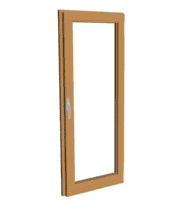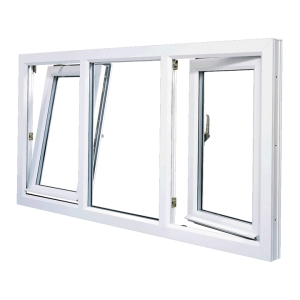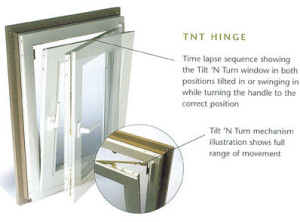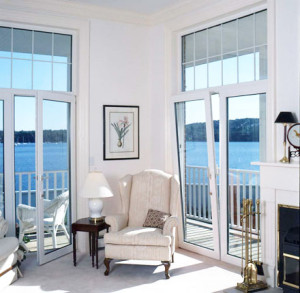Living in Germany, you notice a lot of small engineering innovations that make life easier, like omnidirectional wheels on shopping carts that actually work. One of these innovations in particular stands out, entirely ordinary to Germans, but extraordinary to visitors and newcomers discovering it for the first time: the tilt-and-turn window.

This window is effectively three windows in one: it serves as a fixed window, an inswing casement window and a hopper window.
When the handle of a tilt-and-turn is in the downward position, the window is shut is and locked. Rotate the handle 90 degrees so it points sideways, and you can pull the window open horizontally.
 Now comes the twist: push the window back into place, rotate the handle another 90 degrees so it points up, and then pull it back down toward you. The window tilts inward, opening from the top rather than the side. It then locks into place after opening a few inches, resting at an angle. Each method of opening also aligns intuitively with the different handle positions: pull sideways when the handle is horizontal, and pull down when it is vertical. Warning: functionality aside, changing between these different configurations can be habit forming.
Now comes the twist: push the window back into place, rotate the handle another 90 degrees so it points up, and then pull it back down toward you. The window tilts inward, opening from the top rather than the side. It then locks into place after opening a few inches, resting at an angle. Each method of opening also aligns intuitively with the different handle positions: pull sideways when the handle is horizontal, and pull down when it is vertical. Warning: functionality aside, changing between these different configurations can be habit forming.

So in one configuration, you have a flexible window that swings as you would expect. This orientation also allows for easy cleaning on both sides of the glass while doubling as a good exit window in emergencies.

In the other configuration, the tilt allows in breezes, helps deflect rain and locks into place against potential intrusions. Heat escapes through the top and air enters and exits around the edges, facilitating draft-free ventilation. In other words: you can leave the window open when you are away without worrying too much about security or the weather.

When you switch back to the locked position, you can also feel the multi-point locking mechanisms click into place (up to eight locks depending on the manufacturer). This provides further security and a completely air-tight weather seal, unlike single hung, double hung or sliding windows, all of which are more prone to leaking air or water. When the window is in this closed position, you are also left with an uninterrupted view through a single pane of glass, versus something like a traditional two-piece sash window which may split your view down the center.

Think about the engineering that goes into these things for a moment: a tilt-and-turn opens in two perpendicular directions, requiring hinges for both orientations as well as the mechanical means to engage and disengage each set with the twist of a handle. It is possible (with some effort) to foil the mechanism and get a tilt-and-turn to open incorrectly, pivoting on just one corner connection, but easy to slot back in as well when you are finished willfully abusing your fixture.

But wait, it gets even better: these come as full-sized doors as well. If your narrow back entry has no space for a window next to the door, you can install one of these, then tilt it open to let in a breeze. They are also great for balconies.
And as if all of these functions were not enough already: each of the tilt-and-turn functions is effectively reversible, depending on your design desires and spatial needs. You can, for instance, get a tilt-and-turn that swings outward rather than inward, as well as one that tilts up and out at the bottom, forming an awning.
Originating in Germany and popular in European countries, tilt-and-turns have been around for decades and have slowly made their way further abroad as well. Some countries, however, including the United States, have been slow to adopt them for various reasons.
For starters, there is inertia: architects and builders are used to working with a certain set of familiar and reliable options. Cost may play a part, as these heavily-engineered windows do come with a higher price tag than some of their less-sophisticated counterparts. They also have heavier profiles, so for cases where the functionality would be redundant or excessive, customers looking to maximize light and views may opt for other types. Also, the US has strict codes for commercial buildings that regulate window openings: in most places, a window with a sill lower than three feet high can only open a few inches (though when code calls for an egress window, these are excellent).
There are cultural and architectural factors as well that may have contributed to their relative absence: American Modernism of the 20th Century was obsessed with controlling indoor experiences, from sounds and smells to temperature and breezes. Fixed windows allowed spaces to become fully-regulated, hermetically-sealed environments.
Pushing back against this closed-window trend, many commercial designers and developers today are interested in the benefits of breathing fresh air and giving people more control over their spaces. There is “a growing recognition that giving people individual control over openings in their space can have a positive effect on their experience within a building,” says Jason Jones of Arcsine, our favorite Oakland architecture firm. Operable windows can “even have positive effects on productivity.” Meanwhile, on the residential front, more and more American manufacturers are beginning to make versions of the tilt-and-turn domestically. Between these trends, perhaps this wonderful window will finally become more common in America, but only time will tell.



Comments (18)
Share
Most of these windows have a third open state. When you tilt the handle 45 degrees, the window leaves a tiny gap allowing for air circulation. You would use that e.g. in the winter time when you don’t want cold air to enter your house but you still want still air out.
“giving people individual control over openings in their space can have a positive effect on their experience within a building”
Haha, this reminds me of a documentary about the Dutch Embassy Koolhaas built in Berlin. Appartently Koolhaas had a problem with one of the embassy members (or so I understood from the man’s comments in the movie) and he built a decoratieve window in his office, at about 1,2 meters height, which doubled as the emergency exit for that particulair office. The guy gave a tour and seemed rather irritated by this witty invention.
Marvin has been making tilt turn windows for years, as have some custom window manufacturers. They’re a wonderful product. Other benefits include: having the screen on the outside (unlike a crank-out casement), which provides a cleaner look from inside; the ability to easily wash the outside of the window from inside (which makes washing upper story windows a cinch); ventilation with security in the tilt position (the hardware won’t allow the window to be opened wide enough from the tilt position for someone to get in AND, by putting the alarm sensor at the base of the window, one can tilt open the window for ventilation while the alarm system is set without setting off the alarm). With safety glass, I’ve used them as door substitutes onto french balconies where access from the outside is not an issue. One can get them clad and with various wood choices for the interior. I put 50+ into one project and they have worked out well.
I have never seen a screen on one of these windows in my various trips to Germany, Denmark, England, or the Czech Republic.. and that lack of screens – along with the fact that you can’t put an AC in them – strikes me as the strongest blocker to American adoption.
Either Europe doesn’t have bugs (ha!) or they want to pretend that the bugs don’t bother them, and the same thing with ‘heat’ – which IS less of an issue in northern Europe, certainly…
When there are no bugs and the temperature is reasonable, I DO love this design.
@JB I wouldn’t say they’re everywhere, but they’re very common in Holland.
@ JB, bugs screens are still rarer in Germany than in the US, but they are definitely on the rise.
ACs don’t make sense in most parts of Germany, where you’ll have one or possibly two weeks in summer when you’d *need* them (i.e. temperatures in the 80s even at night). But yeah, they’re difficult to install after building is complete, because you can’t easily knock a hole in the wall (90% of the houses here are brick-and-mortar throughout) for the exhaust. There are solutions that take the exhaust pipe through those windows in the cracked / tilted state, using insulation or simple plastic to fill the rest of the gap. Or a glazier will cut you a hole through the window panes (standard is two, a lot of new windows have three, even, for insulation). But neither solution is pretty, also you lose the use of that window as a point of egress.
Neher is the go to supplier for screens for tilt and turn windows.
Also the sine qua of screen suppliers as well.
http://www.neher.com/
I would think the handle states would make more sense this way
Up: tilt
Middle: locked
Down: turn
Reason being that so many people are already use to handles swinging down to open a door so in an emergency that instinct would take over. Maybe swing handles are not largely prevalent in Germany? I certainly haven’t traveled there and in a lot of Europe, so I’m not sure.
I am German and I hardly ever see any other kind of door handle over here. But since windows are closed or tilted most of the time, it just looks better this way. The handle doesn’t stick out.
Swing handles are the standard in Germany, to the point where I (a German) am often confused by lockable doorknobs in the US (is it push, then twist? Twist, then push? How the heck am I to get out of this person’s bathroom?!)
We grow up with door handles and window handles, and the correct use of both of them is ingrained and works by muscle memory by the age of, I don’t know, ten? No worries about emergencies :)
Bieber does a great job in the custom tilt turn windows.
check it out bieberusa.com
I’ve always fancied the norwegian “H-window” (H-vinduet) to be a better solution. It doesn’t open the window on top, but it doesn’t take inside the room when fully opened:
https://byggmesteren.as/wp-content/uploads/2011/06/H-vindu.jpg
It can also be rotated all the way around for cleaning.
I have lived in a ‘tenement’ flat in Glasgow for over 15 years. Our current flat for five years. Three years ago the owner restored the original sash windows (140 years old) and they were amazing. It is worth noting that many of this style of window also have ’tilt in’ function for cleaning. My former landlord sold the flat to a new owner in February and they decided to replace the whole flat with the ’tilt and turn’ variety. I hate them. Contrary to what everyone here is saying the ventilation (in comparison) is laughable. I could far better control air flow with the old windows as could open from bottom and top and decide how much I wanted to. Now I have two options – the tilt where flow is restricted to the top – or opening them up all the way which firstly takes away privacy (can’t have curtain down) – I live in a city- and let’s in bugs/birds etc…. it is worth noting that my ceiling height is about 14 feet. And they are really heavy
to close- I literally have to put my whole weight against them to close them from tilt function and I am not a weak thing. They may offer options for some homes but in this case I am so annoyed/frustrated/angry/sad they decided to put them in. I hate them- I really do. (As for cleaning imagine the ladder size to get up to get the top and with an open window)
I remember anepisode when they discussed this window and the Japanese sofa built around heating. There was a word used for this type of regional design. What was it?
We lived in Germany for a few years. I really loved it there, and I did regard the tilt & turn windows a novel and fun part of the experience. However, there is no way I would replace my double hung windows in my main US house with them. While the tilt & turns are slightly easier and quicker to open, they really intrude on furniture layout possibilities. They also were a nightmare to me with regards to my small children because they were so easy to open and egress/fall out; further, they rarely came with any kind of precautionary measures to mitigate that issue. We only saw one house out of all the ones we toured with locks on the handles to prevent inadvertent or unwelcome handle operation, and that was the house we took in part because of those handle locks! My 8 year old US windows came standard with tabs to make it difficult for kids to open the windows more than a few inches, and take no floor space up when they are open. Nice double hungs have held onto market share for more reasons than familiarity I think. They really do have a lot of positives.
I have these in my house in western MA. The builder was a distributor for European doors and windows. For me the novelty wore off quickly. You can’t put anything on the sills (is plant). You can’t put furniture near them because the inswing takes up so much space and they are constantly blowing shut with no easy way to lock open (inswing stays are ridiculously hard to find for some reason) so we use beach rocks for now. The cons far out way the pros. I’ve slowly replaced them with standard crank casements as I remodel.
Common all over Europe and standard in a new building. Easily combined with a screen.
I grew up in a window manufacturing family. In 1976 my dad took me to a trade fair in Hannover, Germany. He showed me those great European windows & said he’d love to manufacture those in Canada, but North Americans wouldn’t pay the higher cost for them; that North Americans build houses to last for decades, Europeans build them to last for centuries.